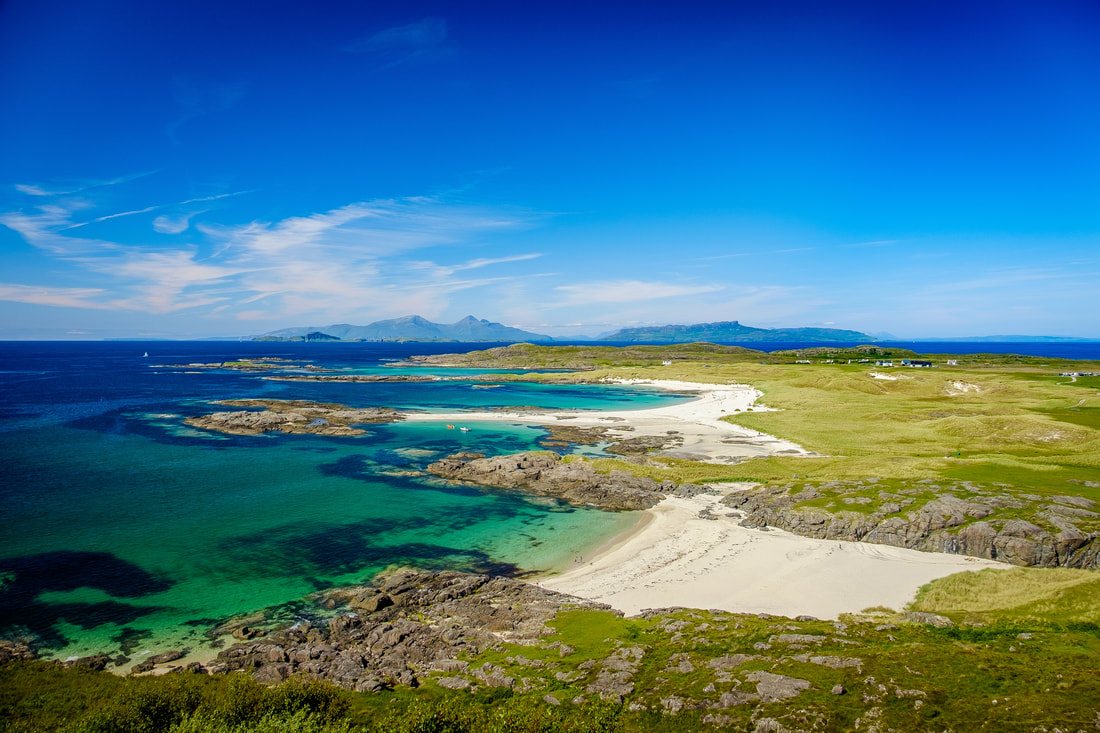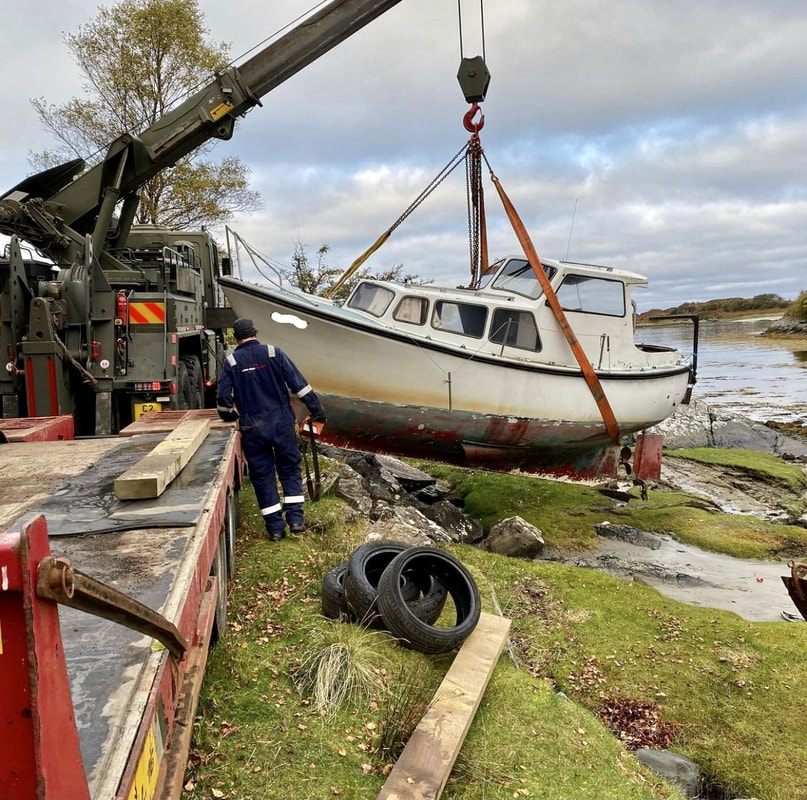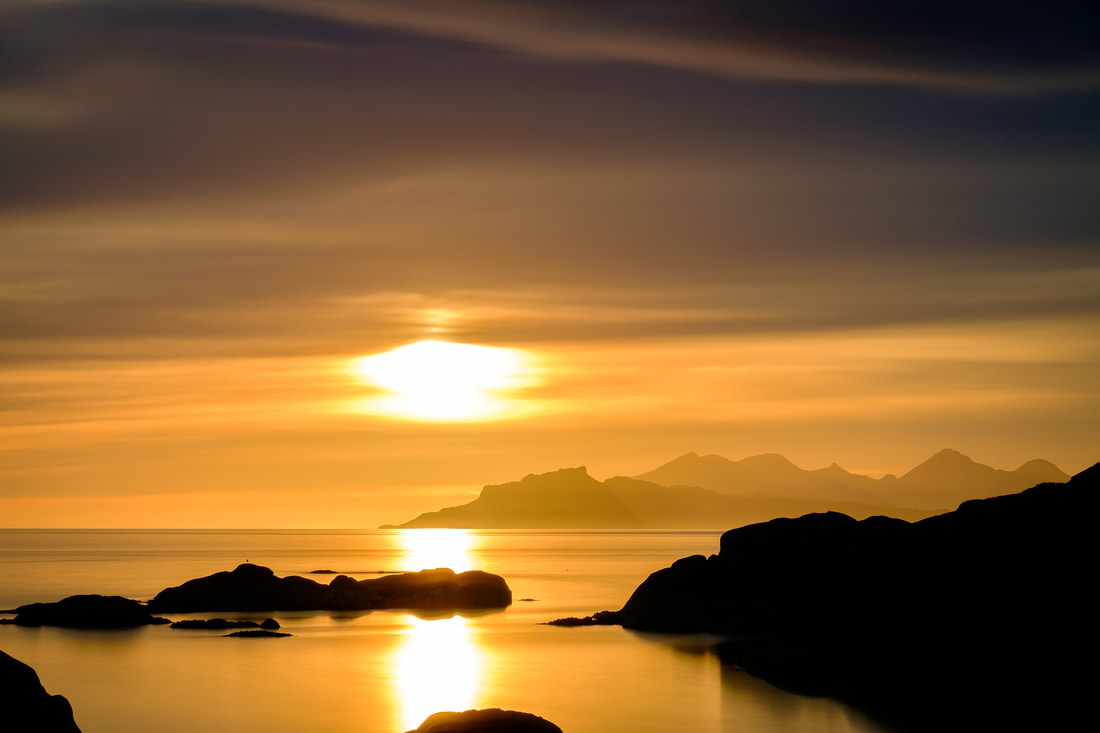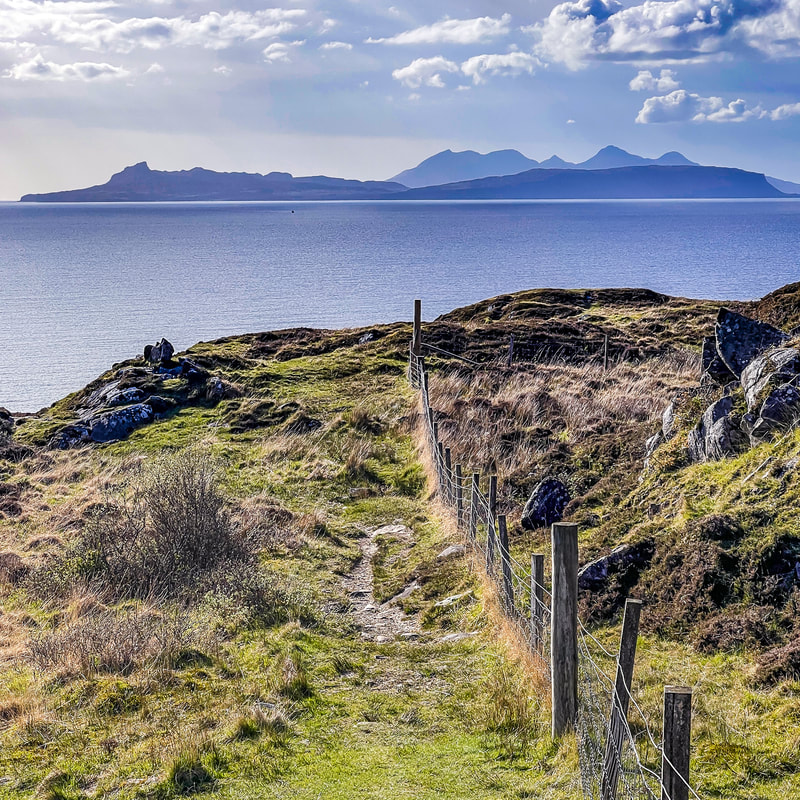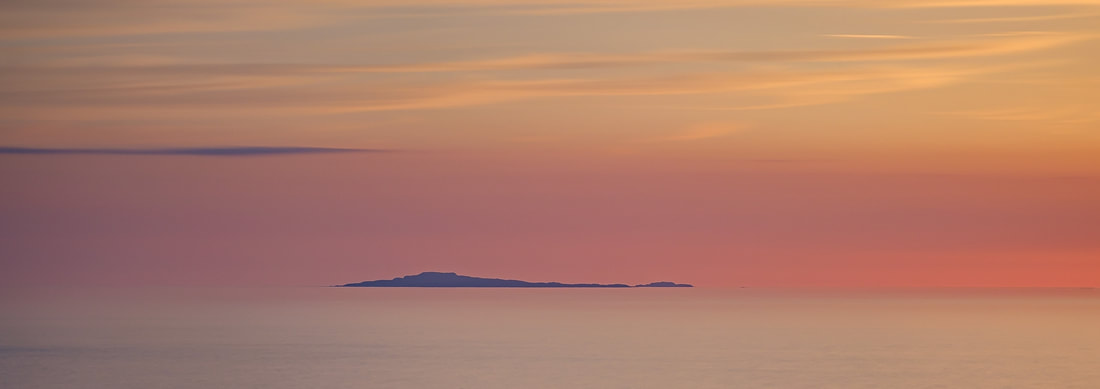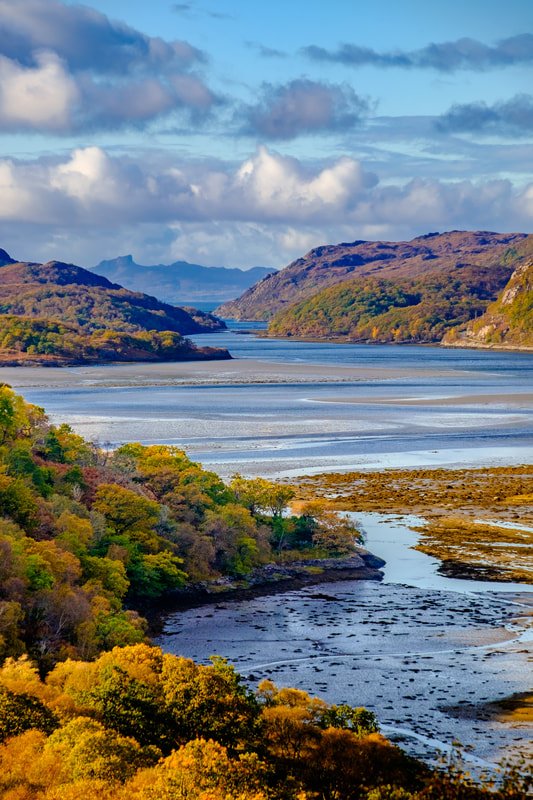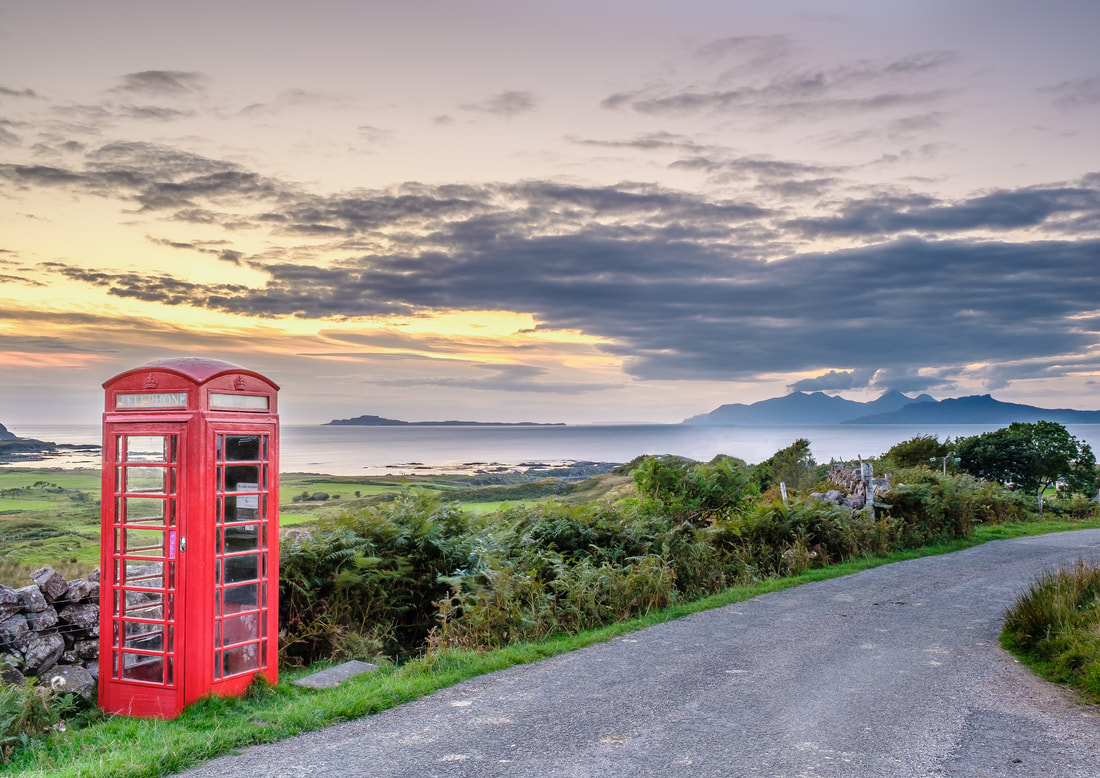|
Despite living on the Peninsula for several years now, it still often feels like it is a world away from the rest of the country and it is little wonder that summer brings a steady stream of visitors seeking to experience this beautiful, remote, and unspoilt corner of the Scottish Highlands. I often say to visitors that it has a bit of everything that Scotland has to offer, with rugged mountains, beautiful lochs and ancient woodlands, but it is its dramatic and stunning coastline that holds the biggest draw for me and features most in my photography Take this month’s image, which was shot on a beautifully sunny day in July out at Sanna, looking north across the bay to the Small Isles beyond. On days such as this, with bright sunlight overhead, the sea takes on an intense range of blue hues ranging from light blues of the shallow water to the dark blues of the deeper water, all caused by the way light interacts with the seawater.
You see, daylight is made up of many different visible colours, ranging from reds and oranges to blues and violets, with the reds and oranges having the longest wavelengths and the blues and violets having the shortest. As water molecules are better at absorbing light with longer wavelengths, they absorb much of the red, orange, yellow and green light. The bluer colours, with shorter wavelengths, are less likely to be absorbed and so are reflected by the white sand on the seabed to give the sea its blue hues. In shallow water, there are fewer water molecules to absorb the red, orange, yellow and green light, so more of it reaches the seabed to be reflected with the blues and violets and give either clear or slightly blue water. However, the deeper the water becomes, the more the reds, oranges, yellows and greens are absorbed and the deeper blue the colour of the water becomes, until you reach the point where no visible light can reach the seabed and the water becomes completely dark. I find something quite captivating about the aquatic blue hues of the sea at places such as Sanna and I’m sure that this is reflected in my affinity for water and for photographing the sea and the coastline. In fact, it has been documented that our affinity for water is reflected in our near-universal attraction to the colour blue and that we associate this colour with qualities like calm, openness, depth and wisdom. The link between the two has even been developed into something called “Blue Mind Science”, the study of aquatic environments’ health benefits that was first popularised by marine biologist Dr Wallace Nichols in his 2014 book, “Blue Mind”. Simply put, Blue Mind is a mildly meditative state that people fall into when they are near, in, under or on water and some of the physical and mental health benefits include:
So, if you’re seeing red, feeling angry, anxious, and stressed, then head to the coast for some “Blue Mindfulness”. I can highly recommend it.
4 Comments
For me, one of the magical things about photography is its ability to capture scenes and moments in the present for the viewers of the future, before they are lost forever, just like the scene in this photo I took in August 2019 of an old sailing boat high up on the rocks at Samalaman Bay near Glenuig. I am so fortunate to be able to live where I do. This special corner of Scotland is a photographer’s paradise with its diverse landscape of mountains, moorland and woodland and an amazing coastline that is home to beautiful white sand beaches and dramatic rocky shorelines. It is a place that has something to offer the photographer in all seasons and in the summer months, the northern coastline of Moidart and Ardnamurchan is the place to go with the camera. In these months, the late evening sun sets in the northwest and brings beautiful sunsets to this part of the West Highland Peninsulas.
r a few years, an old sailing boat had sat perched high up on a huge, rounded rock on the southern edge of the bay, in a position such that it combined with the edges of the bay and the distant silhouette of the Small Isles to create the perfect composition. I visited the bay on a perfectly still August evening in 2019 when a high spring tide coincided with sunset. Even with almost 5 metres of tide, this old sailboat was high enough up on the rocks to remain steadfast in its position. After taking in the scene for a while, I set up my camera on its tripod, set the exposure time to 90 seconds, pressed the shutter button to capture and freeze 1½ minutes of the most magical west coast sunset to create the image at the top of this blog titled “On the Rocks I”.
When I now visit this spot in Samalaman Bay, it certainly feels that something is missing. That old boat sure was essential to the picture-perfect scene that I captured and although I was saddened at its departure, I seek great comfort in knowing that I did manage to capture it before it was gone forever. To me, this ability to capture the present for the viewers of the future is the power of photography and is summed up by this quote by Karl Lagerfeld: “What I like about photographs is that they capture a moment that’s gone forever, impossible to reproduce.”
Views of the Small Isles of Muck, Eigg, Rùm and Canna are ever-changing as you make the journey from east to west along the coast of Moidart and north Ardnamurchan and past its spectacular cliffs, dramatic rocky shores and beautiful white sand beaches. While the dramatic peaks of Rùm’s Cuillin Mountain range are ever present, the distinctive profile of Eigg and its highest hill, An Sgurr, is a prominent feature at first, but it gradually disappears from view to be replaced by the more diminutive profile of Muck as you reach the journey’s end……. IntroductionScotland has 40 National Scenic Areas which cover 13% of its land mass and they earn this designation because their outstanding scenery makes them the country’s finest Landscapes. One of these areas is Morar, Moidart and Ardnamurchan here on Scotland’s north-west coast. It is home to a coastline of spectacular cliffs, dramatic rocky shores and beautiful white sand beaches. Added to all of this are breath-taking views of the Small Isles of Muck, Eigg, Rùm and Canna, which sit a few miles west out in the Sound of Arisaig and just south of the Isle of Skye. As you travel from Moidart in the east, to Ardnamurchan in the west, your perspective of the Small Isles changes significantly, with both them and features on them coming into view and disappearing again after only a few miles. This everchanging view makes photographing both them and this coastline an absolute joy and now that the evening sun is in the north-west, my plan for the coming weeks is to photograph to do just that. My aim is to capture this spectacular coastline while it is bathed in warm sunlight at the end of our long summer days. In the meantime, however, I thought I would describe this somewhat special journey and share some of the images that I already have. Moidart
On reaching Glenuig, you can turn off the main road, drive past the Glenuig Inn and continue westward for about a mile and a half to reach the road end. From there, a short walk takes you to Smirisary, an isolated and roadless crofting village that sits between a rocky foreshore and a steep hillside about two miles to the west of Glenuig. As you walk the final half mile to the village, your view of the sea is obstructed by a small hill, but as you get to the top of it, the view dramatically opens up to reveal islands that you feel you can almost touch (Image 3). I like to visit Smirisary in mid to late summer. It is a great place to capture Muck, Eigg and Rùm sitting in flat calm seas while they are silhouetted against the colourful skies that are a feature of the sunsets there at that time of year. From there, you get a closer view of the distinctive shape of An Sgurr and the dramatic peaks of the Rùm and its Cuillin mountain range, which sits behind Eigg and simply adds to the magic you are witnessing (Image 4).
East ArdnamurchanIf you want to get a view of the Small Isles on this part of your journey, you need to head out to the small but beautiful sandy beach at Ardtoe where a short walk out to the headland on its western side brings the southern end of Eigg and An Sgurr back into view. From there, you also get a glimpse of Rùm because the high peaks of the Rùm Cuillin are just visible above the land that shelters the beach from the open sea (Image 1 and Image 7). While at Ardtoe and if you don’t mind a walk over uneven and often boggy ground, you can make your way out to the end of Rubha Luinngeanach where you get a more open view of Eigg with Rùm behind it. It was at this spot where I witnessed what I think is the most spectacular sunset I have ever seen over the Small Isles (Image 8). I was out there on a rather cloudy July evening, so my hopes of getting a good image were not high. Suddenly the clouds beyond the skerry of Sgeir an Eidigh parted and allowed the most intense of crepuscular rays to shine down on the Isle of Eigg and silhouetted it against the golden backdrop that they had created. It is a moment that is forever etched on my memory. On leaving Ardtoe to head back towards Acharacle, you’ll find that a slight diversion down the road towards Arivegaig rewards you with a fine view out through the entrance of Kentra Bay to Eigg, where An Sgurr sits directly behind the gap between the land and the sea (Image 9). The road to Arivegaig is also a spot where you can catch a full moon setting behind the Rùm Cuillin on a clear winter morning (Image 10). West ArdnamurchanThe next part of the journey west takes you along the side of Loch Sunart and it is a good few miles before you see the Small Isles again because the road now takes you along the southern coast of the Ardnamurchan Peninsula. It is not until you pass Camas nan Geall and follow the road north around the side of Ben Hiant to reach Doire Daraich before they come back into view again (Image 11). Given how far west you have travelled to reach there, the perspective is now very different because Eigg now sits to the right of Rùm, while the drive down to Kilmory brings the Muck back into view as reach the phone box just before the village (Image 12).
It is from the hills above Portuairk from where I think you get the most dramatic view of Rùm and the magnificent peaks of its Cuillin mountain range. It is simply majestic, sitting there beyond Sanna Bay and the significantly more diminutive Isle of Muck (Image 15). While there, it is well worth taking the walk from Portuairk to the beautiful white sand beach at Sanna because, as you climb over the hill that separates the two, another magnificent view of the Small Isles reveals itself (Image 16). It is from there that you can see all the Small Isles because the fourth and, up until now, elusive Isle of Canna reveals itself. If you stop there for a little whole and look north over the beach you can just make it out, sitting well out the west of the Isle of Rùm, which has Eigg to its east and Muck to its south. Journey’s EndOur journey from east to west along this beautiful Moidart and Ardnamurchan coastline ends at Ardnamurchan Point. It is as far west as you can go on the British Mainland and is home to the iconic Ardnamurchan Lighthouse which so many visitors head for when they visit the West Highland Peninsulas.
While you do get a clear view of the Small Isles from there, they do not readily sit in any photographic composition that features the lighthouse because the camera tends to point in a direction looking away from them or is at an angle where the islands are hidden by the lighthouse itself. It takes a walk out on to the rocks of Dubh Rubha Mor at low tide before you can point the camera north, across the bay of Briaghlann, and capture both the lighthouse and the now familiar profile of Rùm and Muck behind it and it seems fitting that I end this journey with an image of the sun setting on this very scene (Image 17). |
AuthorHi, Archives
July 2024
Categories
All
|
Steven Marshall Photography, Rockpool House, Resipole, Strontian, Acharacle, PH36 4HX
Telephone: 01967 431 335 | Mobile: 07585 910 058 | Email: [email protected]
Telephone: 01967 431 335 | Mobile: 07585 910 058 | Email: [email protected]
All Images & Text Copyright © 2024 - Steven Marshall - All Rights Reserved

